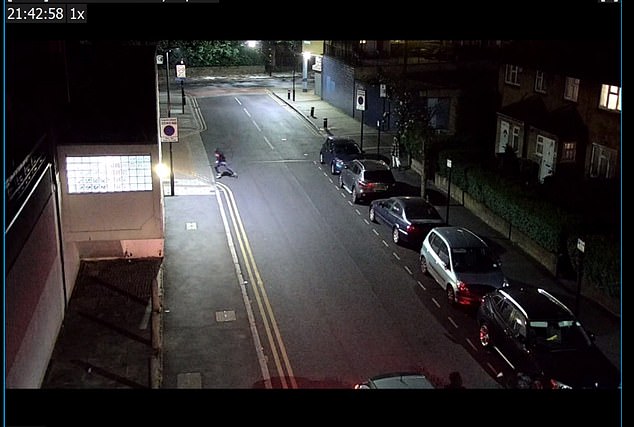No one epitomises the bloody alliance between postcode gangs and drill music more than Lekan ‘Cracky Blacks’ Akinsoji.
His criminal career – including threatening police with a shotgun during a high-speed chase – ended in the dock at the Old Bailey yesterday when he was jailed for life for the murder of a young rival, who was stabbed to death just yards away from his home in east London.
Akinsoji, a sinister figure wearing all-black clothing, a balaclava and gloves, was with an accomplice but he was the ‘stabber’, the person who wielded the knife.
His conviction, following a forensic review, finally brought him to justice eight years after the killing in 2017.
But this is not just a story about Akinsoji, known by his ‘street name’ ’Cracky Blacks’ or ‘CB’ and a leading figure in a Newham gang.
Internecine turf wars, fuelled by drill – a genre of hip hop characterised by dark, violent lyrics – has left a trail of bodies across the capital.
Surely there could not be a more graphic illustration of the symbiotic relationship between the two worlds Akinsoji straddled, if indeed there is any difference, than the track that brought him instant notoriety – Take That Risk – which includes the line: ‘I put Rambo blades in chests, I put flick knives straight in necks.’
The video was released six months after he plunged a knife into the chest of 21-year-old Ahmed Deen-Jah – just like he said in front of the camera – in a corner shop down the road from where he lived in Newham.
Akinsoji, now 27, can still be seen rapping the incriminating words on his Instagram page.
Described as ‘one of the greatest of all time’ drill anthems, the clip has been viewed more than a million times on streaming and social media platforms.
The Metropolitan Police said it is ‘aware’ of 102 ‘active’ gangs like the one Akinsoji belonged to (the Woodgrange ‘outfit’ in Newham) in a freedom of information disclosure last year, the most recent data available.
They cover almost every part of London, as the interactive map on the Daily Mail website illustrates, with names like the Northumberland Park Kids, aka the Sin Squad (Haringey), 67 (Lambeth), Wildbatch (Greenwich), Thugs of Stonebridge (Brent), London Fields, aka Zero Tolerance (Hackney) and Stab to Kill (Croydon).

David Gomoh, 24, seen on CCTV, being chased before he was fatally stabbed because he lived in south Newham, east London

Four gang members, David Ture, Vagnei Colubali, Muhammad Jalloh and Alex Melaku, who stabbed David, pictured, in the street in a ‘brutal murder’ have been jailed for life
These gangs award themselves points for a successful ‘strike’ on a rival with the ‘count’ recorded on a grotesque ‘scoreboard’.
Behind this dystopian landscape are the disturbing statistics which reveal the human cost of their sociopathic behaviour.
Gangs are responsible for almost half of all knife crime in the country, according to the Centre for Social Justice (CSJ) which has conducted research into inner-city gang membership. To put this in context, in the 12 months to August, there were 3,557 stabbings in London, 1,247 resulted in either serious injuries which required hospital treatment or fatalities.
Those figures include the murder of four teenagers so far this year, compared to nine at the same point in 2024, but the overall death toll since 2021 stands at 80.
It means the lives of hundreds of people – friends and families of both victims and perpetrators – have been blighted by ongoing city gang wars.
This is not a criticism of the overstretched and under-resourced Met, just a grim reality of life in the underbelly of London.
One of the ‘hotspots’ is Newham which produced Lekan Akinsoji and, like other boroughs scarred by tribal rivalries, contains some of the most deprived communities in the capital where around 44 per cent of children live in poverty.
Social depravation in these neighbourhoods inevitably coincides with what criminologist Simon Harding, director of the National Centre for Gang Research, calls a ‘landscape of fear’ which can lead young people feeling they ‘need self-protection and thus the need for a knife’.
In Newham, the council estimated that in 2023 less than half of young people aged 16-24 felt safe in the local area – where 903 knife crime offences and 205 stabbings were recorded in the year to August, the most of any borough. (If it is worked out per thousand residents this dubious honour would go to Westminster because of its small population).
Nowhere do those numbers resonate more than on Freemasons Road, a main artery on the border of Custom House and Canning Town. Two women who spoke to us on the pavement outside Custom House station, a terminal for the Docklands Light Railway (DLR), painted a sobering picture of life on this side of the Excel convention and exhibition centre which they call the ‘dark side’.
‘If you walk around you will see flowers dotted around, particularly near parks,’ one explains, referring to floral tributes marking the spot where someone has been murdered. There are no flowers today but three young men have been killed within 500 yards of where she was speaking, which resulted in seven culprits from three different gangs being jailed for life.

No one epitomises the bloody alliance between postcode gangs and drill music more than Lekan ‘Cracky Blacks’ Akinsoji
You know about one of them, Ahmed Deen-Jah, who was cornered and killed in a convenience store just down the road by Akinsoji, a member of the Woodgrange gang, also known as Gaza.
His younger brother, 18-year-old Abubakarr ‘Junior’ Deen-Jah, was stabbed and shot in almost the same spot four years later in 2021 by two so-called ‘foot soldiers’ from the Chadd Green gang, allies of Akinsoji’s mob.
Both the brothers – Ahmed and Junior – wore the colours of the rival Custom House gang; that is why they are dead, nothing else.
In all, at least 20 murders have stemmed from the postcode wars in Newham including, most tragically perhaps, university graduate David Gomoh, the other person to die on Freemasons Road. He was innocent of any gang involvement but was mercilessly and fatally stabbed in 2020.
David wasn’t in the wrong postcode. His four attackers were. They were looking for someone to hurt in rival gang territory, this is called a ‘ride-out’. It would usually be a member of the rival gang in question. But the violence normally reserved for such individuals on these occasions was brought upon David instead.
His murder was not a case of mistaken identity. David, 24, who had just popped out to the shops, was randomly targeted, it emerged at trial, presumably because he was alone and black.
Hard to imagine a more wicked or senseless crime.
His mother Marian, a labour ward matron at Newham University Hospital, is haunted by what happened that Sunday night five years ago. How could she not be?
‘They destroyed my life,’ she told the Daily Mail, unable to hold back the tears. ‘I don’t want any mother to go through what I’ve been through.’
David managed to stagger the short distance back to his terraced house after being targeted.
‘I heard him calling me outside the front door,’ said Marian. ‘I opened the curtains and then the door. He had a splash of blood on his face. I thought it was a nose bleed but then he dropped. I held him up and hugged him. I screamed “my son, my son” and neighbours came to help.’
Marian, 61, had just lost her husband, who died of a Covid-related illness and was days away from burying him. David was a marketing graduate from South Bank University and worked as a supply chain worker for the NHS at St Bartholomew’s Hospital, helping frontline staff treating coronavirus patients. ‘He was my beautiful boy,’ said Marian. ‘He had so much to live for.’
The reality is that mass rivalry has split the east London borough into two factions, Southside Newham and Northside Newham.
Southside is an alliance of those in the south of the borough including Custom House (CH), Beckton Boys, ACG (Anyone Can Go) and ‘crews’ from Canning Town and is known as the 6th (because of its E6 postcode).
Northside includes gangs in the north from the Woodgrange Estate, Forest Gate, Chadd Green Estate and Plaistow and is known as the 7th (related to the E7 postcode). The pathway to these gangs is almost always the same and it is one which was followed by Akinsoji. ‘He was a very talented kid,’ said neighbour Denver Dzora. ‘He was gifted musically.
‘I used to see all these kids on the estate. It’s tragic to see them turn into statistics.’
Akinsoji’s descent into crime emerged at his trial and is chronicled on Substack by freelance journalist Chris Summers, the only reporter to cover the case in full.
By the age of 13, Akinsoji, whose father moved back to his native Nigeria when he was young, had joined the Woodgrange gang, at 17 he was a drill rapper and by 18, he was selling drugs as part of a county lines team operating in the Suffolk town of Bury St Edmunds.
In 2018, he went on a ‘ride-out’ but the stolen BMW he was in with three accomplices was spotted by the police. At one point, Akinsoji, his face covered in a clown mask, pointed a sawn-off shotgun at the pursuing officers and was eventually arrested.
‘I remember the raid on his house,’ recalls Mr Dzora. ‘I think the armed police used stun grenades.’
Akinsoji was charged and convicted of possession of a firearm with intent to endanger life and conspiracy to cause grievous bodily harm with intent.
He was jailed for 20 years in 2019, which will now run concurrently with the minimum of 28 years that he will serve for the murder of Ahmed Deen-Jah.
‘I have no doubt that you were involved in violence against the Custom House gang to enhance your reputation as a drill artist,’ the judge told him, adding: ‘While there is no getting away from the fact that Ahmed Deen-Jah was himself a gang member, no one deserves to die because of that.’
Given that it took eight years to bring him to justice, Akinsoji must have thought he had got away with murder.

Ahmed Jah was stabbed to death in Canning Town in 2017, while buying fruit juice from his local shop
Ten days before the execution Akinsoji appeared on a video entitled ‘Armed and Ready’ about how he intended to avoid getting caught by covering his face, bragging: ‘No face, no case, no evvy [evidence].’
However, following a forensic review of the case last year, when items were submitted for further testing, his DNA was detected on a swab taken from the palm of his victim, who had to die because he had apparently ‘dissed’ the Northside on social media.
‘A punch is no longer good enough now,’ says Professor Simon Harding. ‘It has to be a stab in the heart or the neck.’
The sociopathic mentality at the heart of gang rivalry was laid bare at the Old Bailey when Akinsoji was asked under cross-examination what was meant by the ‘scoreboard’.
‘That is the count between gangs, on both sides,’ he replied. ‘A stabbing would be a point. A shooting, a murder, obviously.’
Akinsoji was then asked: ‘if your gang succeeds… is it something that will get sung about?’ ‘Yes,’ he said, adding: ‘Drill music is violence. That’s what sells. The more graphic, the more gory, the more disrespectful, the more it sells.’
Here, from the mouth of someone at the centre of the carnage, the unvarnished truth about drill music, which apologists have sought to deny.
More stabbings equals more views which equals more respect which in turn equals more stabbings, and so the carousel of violence continues.
The Met used to keep a database to identify those at risk of committing, or being a victim of gang-related violence in London, known as the gangs violence matrix (GVM).
It was scrapped in February 2024 following complaints that the GVM discriminated against black people, who were disproportionately represented.
‘The removal of the matrix was in large part political, with too many legal challenges and lobby groups calling it racist,’ said Edward Davies, research director at the Centre for Social Justice.
When addressing the claim that black people were being discriminated against, he added: ‘There is a difference between the census population and the street population.
‘A lot of gang violence occurs at night. You can rule out old people and very young children, for example. There are different ways of getting statistics to get the results you want.’
Today, it is too early to say if an existing but adapted database chosen to replace the GVM would prove effective.
For the record, however, a report by the Mayor’s office in 2022, found that nearly three quarters – 73 per cent – of teen homicide victims were black males and almost two thirds – 65 per cent – of suspects were also black.
Back in seventies when Stanley Kubrick brought Anthony Burgess’s 1962 novel, A Clockwork Orange, to the screen, audiences were shocked by its portrayal of ‘ultra violence’ in a futuristic Britain.
The plot revolves around a gang called the ‘Droogs’ who wore black bowler hats, braces over white shirts and were armed with baseball bats to commit acts of violence.
For the Droogs, now read Ladbroke Grove Boys (Westminster), North Road Bandits (Camden), Drillford (Redbridge) and Woodgrange (Newham), whose most ‘respected’ member was Lekan ‘Cracky Blacks’ Akinsoji.
Additional reporting by Richard Lemmer and Isaac Crowson








